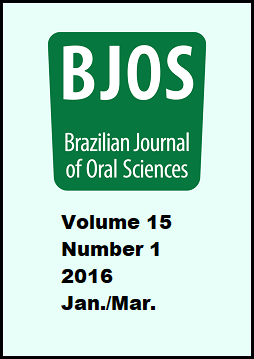Abstract
Aim: To evaluate the prevalence and hygiene habits of 13-19 years-old adolescent users of removable orthodontic appliances (ROA) and to determine hygiene methods for the appliances prescribed by dentists, in the city of Pelotas. Methods: The study had two stages. The first stage was a telephone interview with dentists. Dentists were interview by telephone calls in order to obtain information regarding the hygiene methods for cleaning acrylic appliances. Second stage was a cross-sectional study performed with schoolchildren. Children from public and private schools with secondary level were included in the sample. A questionnaire was applied to the students using any type of ROA. Questionnaires included demographic information and behavioral characteristics. Data collected were subjected to Chi-square test and logistic regression. Results: The prevalence of children using ROA was 5.4%. Students (89.7%) and dentists (47.2%) reported to prefer mechanical methods to clean their ROA. Cleaning with soup, hydrogen peroxide or effervescent tabs were less used. High frequency of use was associated with higher frequency of hygiene on the ROA. Conclusions: The prevalence of schoolchildren using removable appliances was low. The common cleaning method used by children and prescribed by dentists was mechanical. Hygiene frequency was significantly associated with the routine of use of the appliance and with the type of hygiene method.
References
de Couto Nascimento V, de Castro Ferreira Conti AC, de Almeida Cardoso M, Valarelli DP, de Almeida-Pedrin RR. Impact of orthodontic treatment on self-esteem and quality of life of adult patients requiring oral rehabilitation. Angle Orthodont. 2016 Feb.
Dimberg L, Lennartsson B, Arnrup K, Bondemark L. Prevalence and change of malocclusions from primary to early permanent dentition: a longitudinal study. Angle Orthod. 2015 Sep;85(5):728-34. doi: 10.2319/080414-542.1.
Pathak AK, Sharma DS. Biofilm associated microorganisms on removable oral orthodontic appliances in children in the mixed dentition. J Clin Pediatr Dent. 2013 Spring;37(3):335-9.
Chauhan P, Dua VS, Kainth N, Tosh A, Tomar A. The effect of various oral hygiene products on the microbial flora in patients undergoing orthodontic treatment. APOS Trends Orthod. 2015;5(2):63-9.
Nisayif DH. The effects of removable orthodontic appliance hygiene on oral flora. J Bagh College Dentistry. 2009;21(2):105-8.
Friedman M, Harari D, Raz H, Golomb G, Brayer L. Plaque inhibition by sustained release of chlorhexidine from removable appliances. J Dent Res. 1985 Nov;64(11):1319-21.
Salas MMS, Lamas RRS, Cenci TP, Lund RG. How are children and adolescents cleaning their orthodontic appliances? A cross-sectional study in private schools. Braz J Oral Sci. 2014 Jan/Mar;13(1):34-6.
Paranhos HF, Silva-Lovato CH, de Souza RF, Cruz PC, de Freitas-Pontes KM, Watanabe E, et al. Effect of three methods for cleaning dentures on biofilms formed in vitro on acrylic resin. J Prosthodont. 2009 Jul;18(5):427-31. doi: 10.1111/j.1532-849X.2009.00450.x.
Peixoto IT, Enoki C, Ito IY, Matsumoto MA, Nelson-Filho P. Evaluation of home disinfection protocols for acrylic baseplates of removable orthodontic appliances: A randomized clinical investigation. Am J Orthod Dentofacial Orthop. 2011 Jul;140(1):51-7. doi: 10.1016/j.ajodo.2009.12.036.
Madan C, Arora K, Chadha VS, Manjunath BC, Chandrashekar BR, Rama Moorthy VR. A knowledge, attitude, and practices study regarding dental floss among dentists in India. J Indian Soc Periodontol. 2014 May;18(3):361-8. doi: 10.4103/0972-124X.134578.
Bennett S, Woods T, Liyanage WM, Smith DL. A simplified general method for cluster-sample surveys of health in developing countries. World Health Stat Q. 1991;44(3):98-106.
Chestnutt IG, Burden DJ, Steele JG, Pitts NB, Nuttall NM, Morris AJ. The orthodontic condition of children in the United Kingdom, 2003. Br Dent J. 2006 Jun 10;200(11):609-12;quiz 638.
Krey KF, Hirsch C. Frequency of orthodontic treatment in German children and adolescents: influence of age, gender, and socio-economic status. Eur J Orthod. 2012 Apr;34(2):152-7. doi: 10.1093/ejo/cjq155.
O’Brien K, McComb JL, Fox N, Wright J. Factors influencing the uptake of orthodontic treatment. Br J Orthod. 1996 Nov;23(4):331-4.
Zhang YF, Xiao L, Li J, Peng YR, Zhao Z. Young people’s esthetic perception of dental midline deviation. Angle Orthod. 2010 May;80(3):515-20. doi: 10.2319/052209-286.1.
Rossato MB, Unfer B, May LG, Braun KO. Analysis of the effectiveness of different hygiene procedures used in dental prostheses. Oral Health Prev Dent. 2011;9(3):221-7.
Eichenauer J, Serbesis C, Ruf S. Cleaning removable orthodontic appliances: a survey. J Orofac Orthop. 2011 Oct;72(5):389-95. doi: 10.1007/s00056-011-0043-2.
Norton WE, Funkhouser E, Makhija SK, Gordan VV, Bader JD, Rindal DB, et al. Concordance between clinical practice and published evidence: findings from The National Dental Practice-Based Research Network. J Am Dent Assoc. 2014 Jan;145(1):22-31. doi: 10.14219/jada.2013.21.
Frame PS, Sawai R, Bowen WH, Meyerowitz C. Preventive dentistry: practitioners’ recommendations for low-risk patients compared with scientific evidence and practice guidelines. Am J Prev Med. 2000 Feb;18(2):159-62.
Duyck J, Vandamme K, Krausch-Hofmann S, Boon L, De Keersmaecker K, Jalon E, et al. Impact of Denture Cleaning Method and Overnight Storage Condition on Denture Biofilm Mass and Composition: A Cross-Over Randomized Clinical Trial. PLoS One. 2016 Jan 5;11(1):e0145837. doi: 10.1371/journal.pone.0145837.
Sampaio-Maia B, Monteiro-Silva F. Acquisition and maturation of oral microbiome throughout childhood: An update. Dent Res J (Isfahan). 2014 May;11(3):291-301.
Mokdad AH, Remington PL. Measuring health behaviors in populations. Prev Chronic Dis. 2010 Jul;7(4):A75. Epub 2010 Jun 15.
Moura EC, Claro RM, Bernal R, Ribeiro J, Malta DC, Morais Neto O. A feasibility study of cell phone and landline phone interviews for monitoring of risk and protection factors for chronic diseases in Brazil. Cad Saude Publica. 2011 Feb;27(2):277-86.
The Brazilian Journal of Oral Sciences uses the Creative Commons license (CC), thus preserving the integrity of the articles in an open access environment.

